AI-Based Modeling and Monitoring Techniques for Future Intelligent Elastic Optical Networks
Abstract
1. Introduction
- In Section 2, we firstly introduce the background and challenges for modeling the QoT and impairments in EON’s. The potentials of applying ML to estimate network performance are also discussed. Then, we review many previous works on ML-based modeling techniques.
- In Section 3, we firstly review various previous works on ML-based monitoring techniques. Afterwards, the monitoring techniques specifically for failure management are elaborated.
- In Section 4, the use cases for AI-based modeling and monitoring techniques are discussed.
- In Section 5, we provide a lookout for the future of utilizing ML methods in EON by discussing both the challenges and opportunities.
- In Section 6, a conclusion for this paper is provided.
2. AI-Based QoT and Impairment Modeling
2.1. Background and Challenges
- Self-adaptiveness: Analytical models are essential for estimating the QoT of unestablished lightpaths. However, they may not be scalable for all scenarios since the assumptions for these models may be inappropriate when the configuration of traffic optical paths evolves continuously. For instance, the optical amplifier gain spectrum is wavelength-dependent but some models assume the gain to be identical for all channels. This kind of improper assumption may lead to an inaccurate estimation of the ASE noise. Therefore, network planning tools with self-adaptive QoT and impairment models are highly desired to guarantee a high-quality transmission from the BoL to the EoL.
- Efficiency: For many QoT and impairment models, traditional models with high precision may incur burdensome computational requirements. For example, to model the nonlinear impairment, the SSFM [6,29,30,31] can reach a high accuracy if the step size is sufficiently small, which leads to a high complexity. The GN model [7] can provide results in a very short time but the precision is lower than that of the SSFM in most scenarios. Therefore, models that can efficiently make estimations with a high accuracy are desired.
- High tolerance to parameter uncertainty: In a practical system, link parameters can be uncertain due to inaccurate measurements and other reasons. If the uncertainty of the model input exists, there might be a significant deviation between the real value and the model estimation [5]. Therefore, models that are less sensitive to parameter uncertainty are also desired.
2.2. AI-Based QoT Modeling
2.3. AI-Based Impairment Modeling
2.3.1. Nonlinear Noise
2.3.2. Filtering Effect
2.3.3. ASE Noise
3. AI-Based Optical Performance Monitoring
3.1. AI-Based QoT and Impairment Monitoring
3.2. AI-Based Failure Management
4. Use Cases
4.1. Use Case 1: AI-Based Nonlinear Noise Modeling
4.2. Use Case 2: AI-Based Nonlinear Noise Monitoring
4.3. Use Case 3: AI-Based Soft Failure Identification
5. Future Work
- Efficient adaptation scheme. For most of the works mentioned above, the ML-based methods are trained offline with data from simulations or lab experiments before deployment. Since the weights and parameters of the ML-based methods are fixed after training, the calculation time will be short when using these methods in a practical system. This firstly-trained-then-deployed scheme is efficient for adopting ML-based methods for situations that require a fast response time. However, the data from real scenes may be different from the simulation data. Therefore, a reasonable adaptation scheme is also needed after deployment. In EON, online learning approaches such as retraining are preferable to cope with time-evolving network scenarios [73]. Even though collecting data from the practical system for retraining has been proposed in many works, the rationality for the retraining scheme needs to be reconsidered. Since the change of the EON may be unpredictable, data collected from the real scenes may not follow the same distribution with the original training data. In this case, the collected data cannot be mixed with the pre-training data to adapt the ML-based modeling/monitoring agents. Besides, if retraining agents only use the data collected from the practical system, there are other problems. On the one hand, if retraining is performed frequently for a better adaptation, dataset collected in a short period is relatively small and overfitting may occur. On the other hand, if the retraining is not frequent, estimators may have large deviations when the network state changes at a fast pace. Therefore, how to deploy an efficient adaptation scheme should be carefully considered.
- Reasonable design of ML structure. To reach a higher accuracy, ML algorithms with more complex structures are introduced, such as DGCNN, reinforcement learning and generative adversarial network (GAN). However, these ML methods with complex structures may be hard to deploy in an optical system since they require large memories. Therefore, cost-effective ML methods are desired for EON and the structures of ML methods need to be adjusted to be tailored for the optical system.
- Interpretability of ML-based approaches. Many works discussed in this paper are based on a neural network, which is a flexible structure for classification and regression. However, those ML algorithms often cannot provide concrete explanations for their decisions to a satisfactory extent [74]. Therefore, it is difficult to guarantee the algorithmic fairness of ML methods, which is an obstacle for deploying ML techniques to real systems. More works are desired to make ML methods interpretable to scientifically make sure that these methods can perform as expected.
- Deployment of the ML engine. Many approaches for modeling and monitoring with ML have been proposed recently. Where to deploy these ML engines is another problem. Some ML engines can be embedded in receivers to build a low latency system while some need to be deployed in the control plane to obtain information from the whole optical networks [75]. Therefore, the strategies for the deployment of the ML engine can be carefully designed to reach an optimum performance of the ML-based method.
6. Conclusions
Author Contributions
Funding
Conflicts of Interest
References
- Berthold, J.; Saleh, A.A.M.; Blair, L.; Simmons, J.M. Optical networking: Past, present, and future. J. Lightwave Technol. 2008, 26, 1104–1118. [Google Scholar] [CrossRef]
- Dong, Z.; Khan, F.N.; Sui, Q.; Zhong, K.; Lu, C.; Lau, A.P.T. Optical performance monitoring: A review of current and future technologies. J. Lightwave Technol. 2016, 34, 525–543. [Google Scholar] [CrossRef]
- Pointurier, Y. Design of low-margin optical networks. J. Opt. Commun. Netw. 2017, 9, A9. [Google Scholar] [CrossRef]
- Rottondi, C.; Barletta, L.; Giusti, A.; Tornatore, M. Machine-learning method for quality of transmission prediction of unestablished lightpaths. J. Opt. Commun. Netw. 2018, 10, A286. [Google Scholar] [CrossRef]
- Zhuge, Q.; Zeng, X.; Lun, H.; Cai, M.; Liu, X.; Yi, L.; Hu, W. Application of machine learning in fiber nonlinearity modeling and monitoring for elastic optical networks. J. Lightwave Technol. 2019, 37, 3055–3063. [Google Scholar] [CrossRef]
- Sinkin, O.V.; Holzlohner, R.; Zweck, J.; Menyuk, C.R. Optimization of the split-step fourier method in modeling optical-fiber communications systems. J. Lightwave Technol. 2003, 21, 61–68. [Google Scholar] [CrossRef]
- Poggiolini, P. The GN model of non-linear propagation in uncompensated coherent optical systems. J. Lightwave Technol. 2012, 30, 3857–3879. [Google Scholar] [CrossRef]
- Cheeseman, P.; Gevarter, W. Introduction to artificial intelligence. In Proceedings of the 24th Aerospace Sciences Meeting, American Institute of Aeronautics and Astronautics, Reno, NV, USA, 6–8 January 1986. [Google Scholar]
- Zhang, B.; Zhang, R.; Zhang, Q.; Xin, X. Optical filtering penalty estimation using artificial neural network in elastic optical networks with cascaded reconfigurable optical add–drop multiplexers. Opt. Eng. 2019, 58, 076105. [Google Scholar]
- Sartzetakis, I.; Christodoulopoulos, K.; Varvarigos, E. (Manos) Accurate quality of transmission estimation with machine learning. J. Opt. Commun. Netw. 2019, 11, 140. [Google Scholar] [CrossRef]
- Svozil, D.; Kvasnicka, V.; Pospichal, J. Introduction to multi-layer feed-forward neural networks. Chemom. Intell. Lab. Syst. 1997, 39, 43–62. [Google Scholar] [CrossRef]
- Lun, H.; Zhuge, Q.; Fu, M.; Wu, Y.; Liu, Q.; Cai, M.; Zeng, X.; Hu, W. Soft failure identification in optical networks based on convolutional neural network. In Proceedings of the 2019 European Conference on Optical Communication, Dublin, Ireland, 22–26 September 2019; p. P104. [Google Scholar]
- Tanimura, T.; Hoshida, T.; Kato, T.; Watanabe, S.; Morikawa, H. Data-analytics-based optical performance monitoring technique for optical transport networks. In Proceedings of the Optical Fiber Communication Conference, San Diego, CA, USA, 11–15 March 2018; p. Tu3E.3. [Google Scholar]
- Khan, F.N.; Shen, T.S.R.; Zhou, Y.; Lau, A.P.T.; Lu, C. Optical performance monitoring using artificial neural networks trained with empirical moments of asynchronously sampled signal amplitudes. IEEE Photonics Technol. Lett. 2012, 24, 982–984. [Google Scholar] [CrossRef]
- Shariati, B.; Ruiz, M.; Comellas, J.; Velasco, L. Learning from the optical spectrum: Failure detection and identification. J. Lightwave Technol. 2019, 37, 433–440. [Google Scholar] [CrossRef]
- Musumeci, F.; Rottondi, C.; Nag, A.; Macaluso, I.; Zibar, D.; Ruffini, M.; Tornatore, M. An overview on application of machine learning techniques in optical networks. IEEE Commun. Surv. Tutor. 2019, 21, 1383–1408. [Google Scholar] [CrossRef]
- Khan, F.N.; Fan, Q.; Lu, C.; Lau, A.P.T. An optical communication’s perspective on machine learning and Its applications. J. Lightwave Technol. 2019, 37, 493–516. [Google Scholar] [CrossRef]
- Rafique, D.; Velasco, L. Machine learning for network automation: Overview, architecture, and applications [Invited Tutorial]. J. Opt. Commun. Netw. 2018, 10, D126. [Google Scholar] [CrossRef]
- Mata, J.; de Miguel, I.; Durán, R.J.; Merayo, N.; Singh, S.K.; Jukan, A.; Chamania, M. Artificial intelligence (AI) methods in optical networks: A comprehensive survey. Opt. Switch. Netw. 2018, 28, 43–57. [Google Scholar] [CrossRef]
- Fang, W.; Lu, M.; Liu, X.; Gong, L.; Zhu, Z. Joint defragmentation of optical spectrum and IT resources in elastic optical datacenter interconnections. J. Opt. Commun. Netw. 2015, 7, 314–324. [Google Scholar] [CrossRef]
- Delezoide, C.; Christodoulopoulos, K.; Kretsis, A.; Argyris, N.; Kanakis, G.; Sgambelluri, A.; Sambo, N.; Giardina, P.; Bernini, G.; Roccato, D.; et al. Marginless operation of optical networks. J. Lightwave Technol. 2019, 37, 1698–1705. [Google Scholar] [CrossRef]
- Channegowda, M.; Nejabati, R.; Simeonidou, D. Software-defined optical networks technology and infrastructure: Enabling software-defined optical network operations [Invited]. J. Opt. Commun. Netw. 2013, 5, A274–A282. [Google Scholar] [CrossRef]
- Panayiotou, T.; Chatzis, S.P.; Ellinas, G. Performance analysis of a data-driven quality-of-transmission decision approach on a dynamic multicast-capable metro optical network. J. Opt. Commun. Netw. 2017, 9, 98–108. [Google Scholar] [CrossRef]
- Politi, C.; Anagnostopoulos, V.; Matrakidis, C.; Stavdas, A. Physical layer impairment aware routing algorithms based on analytically calculated Q-factor. In Proceedings of the 2006 Optical Fiber Communication Conference and the National Fiber Optic Engineers Conference, Anaheim, CA, USA, 5–10 March 2006; p. 3. [Google Scholar]
- Ellinas, G.; Antoniades, N.; Panayiotou, T.; Hadjiantonis, A.; Levine, A.M. Multicast routing algorithms based on Q-factor physical-layer constraints in metro networks. IEEE Photonics Technol. Lett. 2009, 21, 365–367. [Google Scholar] [CrossRef]
- Velasco, L.; Shariati, B.; Boitier, F.; Layec, P.; Ruiz, M. Learning life cycle to speed up autonomic optical transmission and networking adoption. J. Opt. Commun. Netw. 2019, 11, 226. [Google Scholar] [CrossRef]
- Zhang, F.; Zhuge, Q.; Plant, D.V. Fast analytical evaluation of fiber nonlinear noise variance in mesh optical networks. J. Opt. Commun. Netw. 2017, 9, C88–C97. [Google Scholar] [CrossRef]
- Pastorelli, R.; Bosco, G.; Piciaccia, S.; Forghieri, F. Network planning strategies for next-generation flexible optical networks [Invited]. J. Opt. Commun. Netw. 2015, 7, A511–A525. [Google Scholar] [CrossRef]
- Shao, J.; Liang, X.; Kumar, S. Comparison of split-step Fourier schemes for simulating fiber optic communication systems. IEEE Photonics J. 2014, 6, 7200515. [Google Scholar]
- Muslu, G.M.; Erbay, H.A. Higher-order split-step Fourier schemes for the generalized nonlinear Schrödinger equation. Math. Comput. Simul. 2005, 67, 581–595. [Google Scholar] [CrossRef]
- Musetti, S.; Serena, P.; Bononi, A. On the accuracy of split-step Fourier simulations for wideband nonlinear optical communications. J. Lightwave Technol. 2018, 36, 5669–5677. [Google Scholar] [CrossRef]
- Murty, M.N.; Devi, V.S. Introduction to Pattern Recognition and Machine Learning; IISc Lecture Notes Series; Co-Published with Indian Institute of Science (IISc): Bangalore, India, 2015; Volume 5, ISBN 978-981-4335-45-4. [Google Scholar]
- Mo, W.; Huang, Y.-K.; Zhang, S.; Ip, E.; Kilper, D.C.; Aono, Y.; Tajima, T. ANN-based transfer learning for QoT prediction in real-time mixed line-rate systems. In Proceedings of the Optical Fiber Communication Conference, San Diego, CA, USA, 11–15 March 2018; p. W4F.3. [Google Scholar]
- Zhu, S.; Gutterman, C.L.; Mo, W.; Li, Y.; Zussman, G.; Kilper, D.C. Machine learning based prediction of Erbium-Doped fiber WDM Line amplifier gain spectra. In Proceedings of the 2018 European Conference on Optical Communication (ECOC), Rome, Italy, 23–27 September 2018; pp. 1–3. [Google Scholar]
- You, Y.; Jiang, Z.; Janz, C. Machine learning-based EDFA gain model. In Proceedings of the 2018 European Conference on Optical Communication (ECOC), Rome, Italy, 23–27 September 2018; pp. 1–3. [Google Scholar]
- Mo, W.; Zhu, S.; Li, Y.; Kilper, D.C. EDFA wavelength dependent gain spectrum measurement using weak optical probe sampling. IEEE Photonics Technol. Lett. 2018, 30, 177–180. [Google Scholar] [CrossRef]
- Yan, S.; Khan, F.N.; Mavromatis, A.; Gkounis, D.; Fan, Q.; Ntavou, F.; Nikolovgenis, K.; Meng, F.; Salas, E.H.; Guo, C.; et al. Field trial of machine-learning-assisted and SDN-based optical network planning with network-scale monitoring database. In Proceedings of the 2017 European Conference on Optical Communication (ECOC), Gothenburg, Sweden, 17–21 September 2017; pp. 1–3. [Google Scholar]
- Morais, R.M.; Pedro, J. Machine learning models for estimating quality of transmission in DWDM networks. J. Opt. Commun. Netw. 2018, 10, D84. [Google Scholar] [CrossRef]
- Wang, J.; Luo, S. Exploiting ensemble method in semi-supervised learning. In Proceedings of the 2006 International Conference on Machine Learning and Cybernetics, Dalian, China, 13–16 August 2006; pp. 1104–1107. [Google Scholar]
- Wilcox, R.R. A note on the Theil-Sen regression estimator when the regressor Is random and the error term is heteroscedastic. Biom. J. 1998, 8, 261–268. [Google Scholar] [CrossRef]
- Wong, S.C.; Gatt, A.; Stamatescu, V.; McDonnell, M.D. Understanding data augmentation for classification: When to warp? arXiv 2016, arXiv:1609.08764. [Google Scholar]
- Van Dyk, D.A.; Meng, X.-L. The art of data augmentation. J. Comput. Gr. Stat. 2001, 10, 1–50. [Google Scholar] [CrossRef]
- Michie, D.; Spiegelhalter, D.J.; Taylor, C.C. Machine Learning, Neural and Statistical Classification; Prentice Hall: Englewood Cliffs, NJ, USA, 1994. [Google Scholar]
- Côté, D. Using machine learning in communication networks [Invited]. J. Opt. Commun. Netw. 2018, 10, D100. [Google Scholar] [CrossRef]
- Jia, Y.; Shelhamer, E.; Donahue, J.; Karayev, S.; Long, J.; Girshick, R.; Guadarrama, S.; Darrell, T. Caffe: Convolutional architecture for fast feature embedding. arXiv 2014, arXiv:1408.5093. [Google Scholar]
- Panayiotou, T.; Savva, G.; Shariati, B.; Tomkos, I.; Ellinas, G. Machine learning for QoT estimation of unseen optical network states. In Proceedings of the Optical Fiber Communication Conference (OFC) 2019, San Diego, CA, USA, 3–7 March 2019; p. Tu2E.2. [Google Scholar]
- De Miguel, I.; Durán, R.J.; Jiménez, T.; Fernández, N.; Aguado, J.C.; Lorenzo, R.M.; Caballero, A.; Tafur Monroy, I.; Ye, Y.; Tymecki, A.; et al. Cognitive dynamic optical networks [Invited]. J. Opt. Commun. Netw. 2013, 5, A107. [Google Scholar] [CrossRef]
- Jimenez, T.; Aguado, J.C.; de Miguel, I.; Duran, R.J.; Angelou, M.; Merayo, N.; Fernandez, P.; Lorenzo, R.M.; Tomkos, I.; Abril, E.J. A cognitive quality of transmission estimator for core optical networks. J. Lightwave Technol. 2013, 31, 942–951. [Google Scholar] [CrossRef]
- Sambo, N.; Pointurier, Y.; Cugini, F.; Valcarenghi, L.; Castoldi, P.; Tomkos, I. Lightpath establishment assisted by offline QoT estimation in transparent optical networks. J. Opt. Commun. Netw. 2010, 2, 928–937. [Google Scholar] [CrossRef]
- Meng, F.; Yan, S.; Nikolovgenis, K.; Ou, Y.; Wang, R.; Bi, Y.; Hugues-Salas, E.; Nejabati, R.; Simeonidou, D. Field trial of gaussian process learning of function-agnostic channel performance under uncertainty. In Proceedings of the Optical Fiber Communication Conference, San Diego, CA, USA, 11–15 March 2018; p. W4F.5. [Google Scholar]
- Seve, E.; Pesic, J.; Delezoide, C.; Bigo, S.; Pointurier, Y. Learning process for reducing uncertainties on network parameters and design margins. J. Opt. Commun. Netw. 2018, 10, A298. [Google Scholar] [CrossRef]
- Xia, L.; Zhang, J.; Hu, S.; Zhu, M.; Song, Y.; Qiu, K. Transfer learning assisted deep neural network for OSNR estimation. Opt. Express 2019, 27, 19398. [Google Scholar] [CrossRef]
- Poggiolini, P.; Bosco, G.; Carena, A.; Curri, V.; Jiang, Y.; Forghieri, F. A simple and effective closed-form GN model correction formula accounting for signal non-gaussian distribution. J. Lightwave Technol. 2015, 33, 459–473. [Google Scholar] [CrossRef]
- Bolshtyansky, M. Spectral hole burning in erbium-doped fiber amplifiers. J. Lightwave Technol. 2003, 21, 1032–1038. [Google Scholar] [CrossRef]
- Woodward, S.L.; Nelson, L.E.; Feuer, M.D.; Zhou, X.; Magill, P.D.; Foo, S.; Hanson, D.; Sun, H.; Moyer, M.; O’Sullivan, M. Characterization of real-time PMD and chromatic dispersion monitoring in a High-PMD 46-Gb/s transmission system. IEEE Photonics Technol. Lett. 2008, 20, 2048–2050. [Google Scholar] [CrossRef]
- Geyer, J.C.; Fludger, C.R.S.; Duthel, T.; Schulien, C.; Schmauss, B. Optical performance monitoring using a 43Gb/s realtime coherent receiver. In Proceedings of the 2009 IEEE/LEOS Summer Topical Meeting, Newport Beach, CA, USA, 20–22 July 2009; pp. 93–94. [Google Scholar]
- Tanimura, T.; Hoshida, T.; Rasmussen, J.C.; Suzuki, M.; Morikawa, H. OSNR monitoring by deep neural networks trained with asynchronously sampled data. In Proceedings of the 2016 21st OptoElectronics and Communications Conference (OECC) Held Jointly with 2016 International Conference on Photonics in Switching (PS), Niigata, Japan, 3–7 July 2016. [Google Scholar]
- Wang, D.; Zhang, M.; Li, J.; Li, Z.; Li, J.; Song, C.; Chen, X. Intelligent constellation diagram analyzer using convolutional neural network-based deep learning. Opt. Express 2017, 25, 17150–17166. [Google Scholar] [CrossRef]
- Tanimura, T.; Hoshida, T.; Kato, T.; Watanabe, S.; Morikawa, H. Convolutional neural network-based optical performance monitoring for optical transport networks. J. Opt. Commun. Netw. 2019, 11, A52. [Google Scholar] [CrossRef]
- Tan, M.C.; Khan, F.N.; Al-Arashi, W.H.; Zhou, Y.; Tao Lau, A.P. Simultaneous optical performance monitoring and modulation format/bit-rate identification using principal component analysis. J. Opt. Commun. Netw. 2014, 6, 441–448. [Google Scholar] [CrossRef]
- Khan, F.N.; Yu, Y.; Tan, M.C.; Yu, C.; Lau, A.P.T.; Lu, C. Simultaneous OSNR monitoring and modulation format identification using asynchronous single channel sampling. In Proceedings of the Asia Communications and Photonics Conference 2015, Hong Kong, China, 19–23 November 2015; p. AS4F.6. [Google Scholar]
- Khan, F.N.; Zhong, K.; Zhou, X.; Al-Arashi, W.H.; Yu, C.; Lu, C.; Lau, A.P.T. Joint OSNR monitoring and modulation format identification in digital coherent receivers using deep neural networks. Opt. Express 2017, 25, 17767. [Google Scholar] [CrossRef] [PubMed]
- Anderson, T.B.; Kowalczyk, A.; Clarke, K.; Dods, S.D.; Hewitt, D.; Li, J.C. Multi Impairment monitoring for optical networks. J. Lightwave Technol. 2009, 27, 3729–3736. [Google Scholar] [CrossRef]
- Wang, C.; Fu, S.; Xiao, Z.; Tang, M.; Liu, D. Long short-term memory neural network (LSTM-NN) enabled accurate optical signal-to-noise ratio (OSNR) monitoring. J. Lightwave Technol. 2019, 37, 4140–4146. [Google Scholar] [CrossRef]
- Wang, Z.; Yang, A.; Guo, P.; He, P. OSNR and nonlinear noise power estimation for optical fiber communication systems using LSTM based deep learning technique. Opt. Express 2018, 26, 21346. [Google Scholar] [CrossRef]
- Skoog, R.A.; Banwell, T.C.; Gannett, J.W.; Habiby, S.F.; Pang, M.; Rauch, M.E.; Toliver, P. Automatic identification of impairments using support vector machine pattern classification on eye diagrams. IEEE Photonics Technol. Lett. 2006, 18, 2398–2400. [Google Scholar] [CrossRef]
- Kashi, A.S.; Zhuge, Q.; Cartledge, J.; Borowiec, A.; Charlton, D.; Laperle, C.; O’Sullivan, M. Artificial neural networks for fiber nonlinear noise estimation. In Proceedings of the Asia Communications and Photonics Conference, Guangzhou, China, 10–13 November 2017; p. Su1B.6. [Google Scholar]
- Vaquero Caballero, F.J.; Ives, D.; Zhuge, Q.; O’Sullivan, M.; Savory, S.J. Joint estimation of linear and non-linear signal-to-noise ratio based on neural networks. In Proceedings of the Optical Fiber Communication Conference, San Diego, CA, USA, 11–15 March 2018; p. M2F.4. [Google Scholar]
- Zhang, K.; Fan, Y.; Ye, T.; Tao, Z.; Oda, S.; Tanimura, T.; Akiyama, Y.; Hoshida, T. Fiber nonlinear noise-to-signal ratio estimation by machine learning. In Proceedings of the Optical Fiber Communication Conference (OFC) 2019, San Diego, CA, USA, 3–7 March 2019; p. Th2A.45. [Google Scholar]
- Vela, A.P.; Ruiz, M.; Fresi, F.; Sambo, N.; Cugini, F.; Meloni, G.; Poti, L.; Velasco, L.; Castoldi, P. BER degradation detection and failure identification in elastic optical networks. J. Lightwave Technol. 2017, 35, 4595–4604. [Google Scholar] [CrossRef]
- Shahkarami, S.; Musumeci, F.; Cugini, F.; Tornatore, M. Machine-learning-based soft-failure detection and identification in optical networks. In Proceedings of the Optical Fiber Communication Conference, San Diego, CA, USA, 11–15 March 2018; p. M3A.5. [Google Scholar]
- Varughese, S.; Lippiatt, D.; Richter, T.; Tibuleac, S.; Ralph, S.E. Identification of soft failures in optical links using low complexity anomaly detection. In Proceedings of the Optical Fiber Communication Conference (OFC) 2019, San Diego, CA, USA, 3–7 March 2019; p. W2A.46. [Google Scholar]
- Musumeci, F.; Rottondi, C.; Corani, G.; Shahkarami, S.; Cugini, F.; Tornatore, M. A tutorial on machine learning for failure management in optical networks. J. Lightwave Technol. 2019, 37, 4125–4139. [Google Scholar] [CrossRef]
- Vellido, A.; Martın-Guerrero, J.D.; Lisboa, P.J.G. Making machine learning models interpretable. Comput. Intell. 2012, 12, 163–172. [Google Scholar]
- Boitier, F.; Layec, P. Automated optical networks with monitoring and machine learning. In Proceedings of the 2018 20th International Conference on Transparent Optical Networks (ICTON), Bucharest, Romania, 1–5 July 2018; pp. 1–4. [Google Scholar]
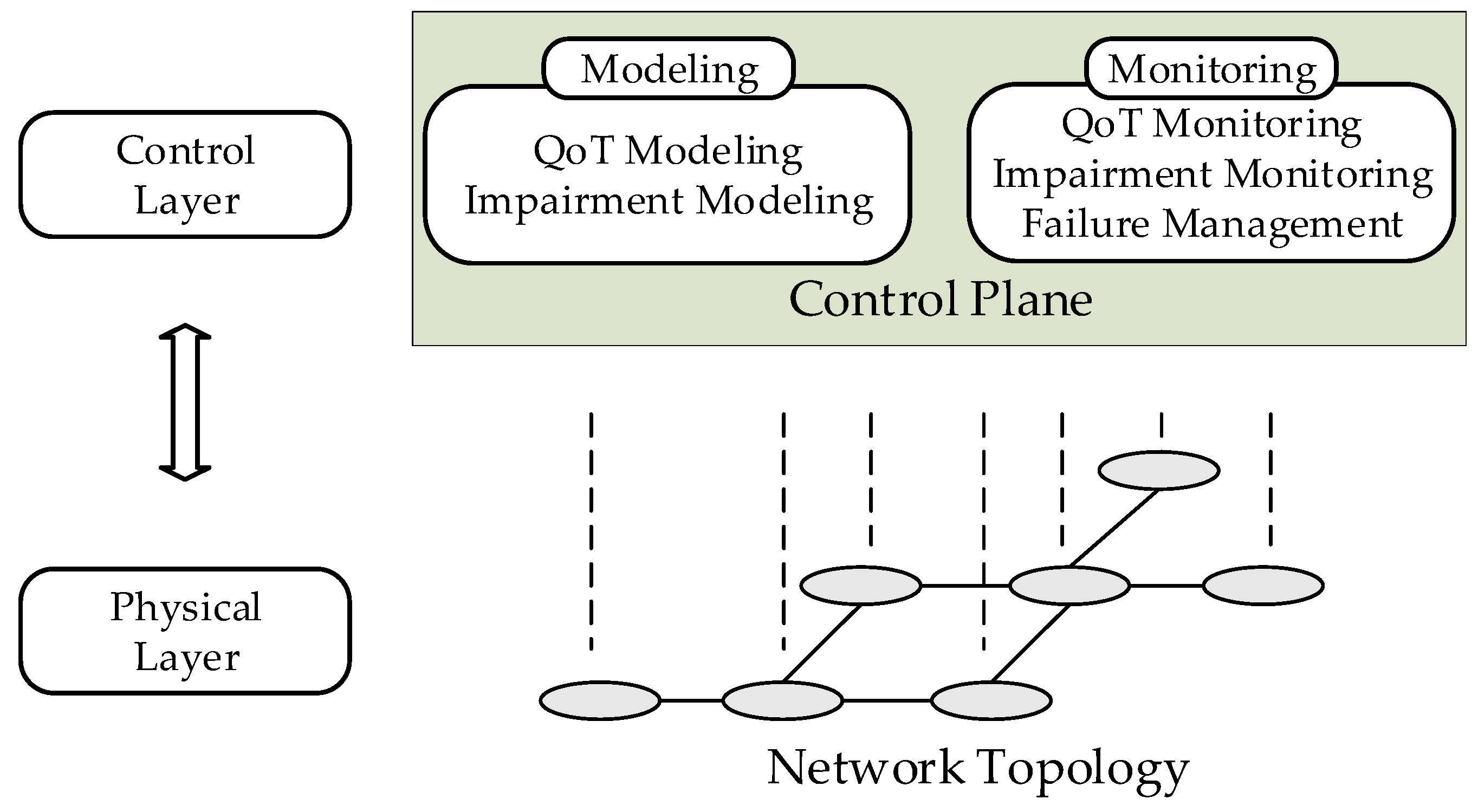
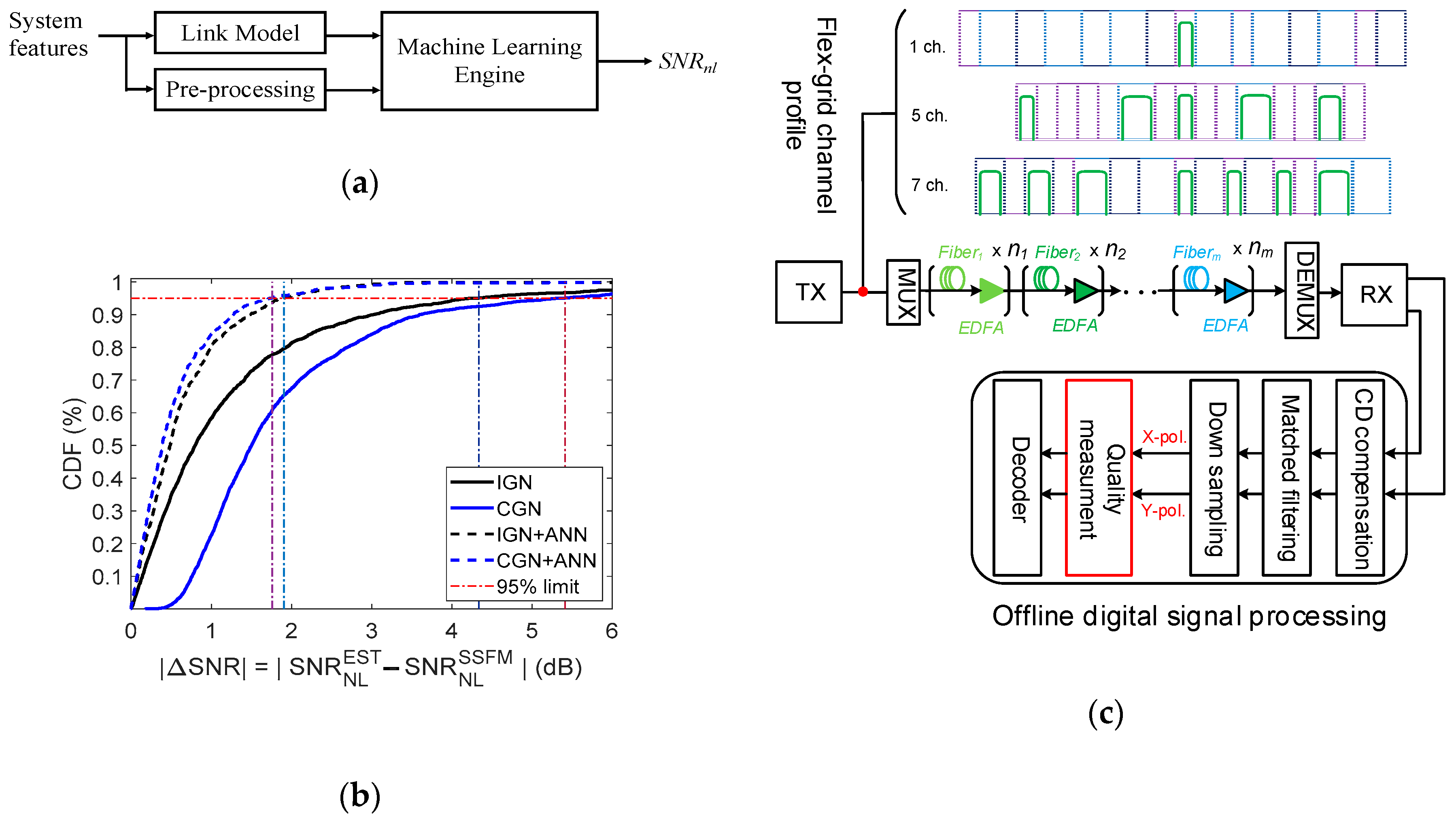
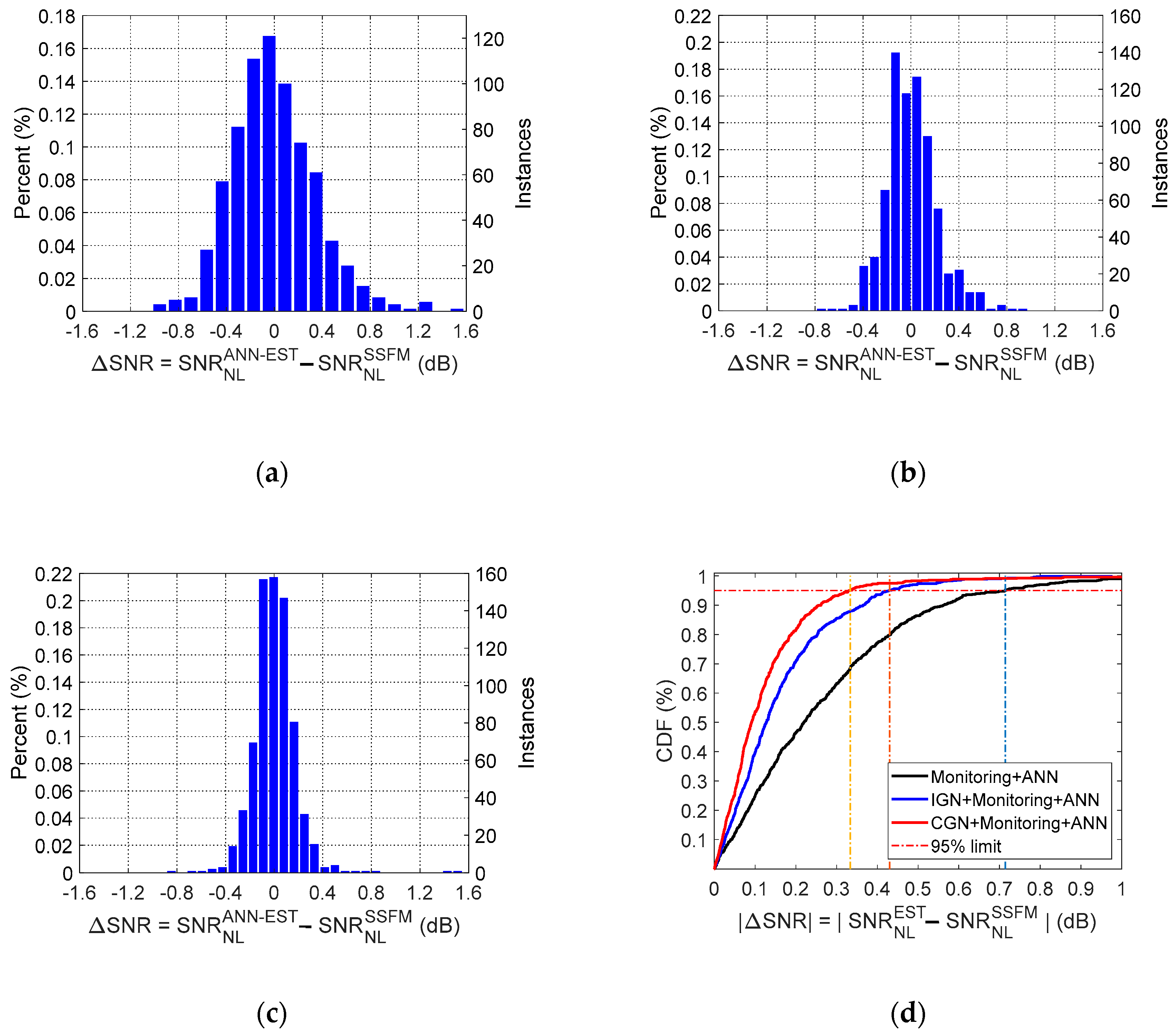
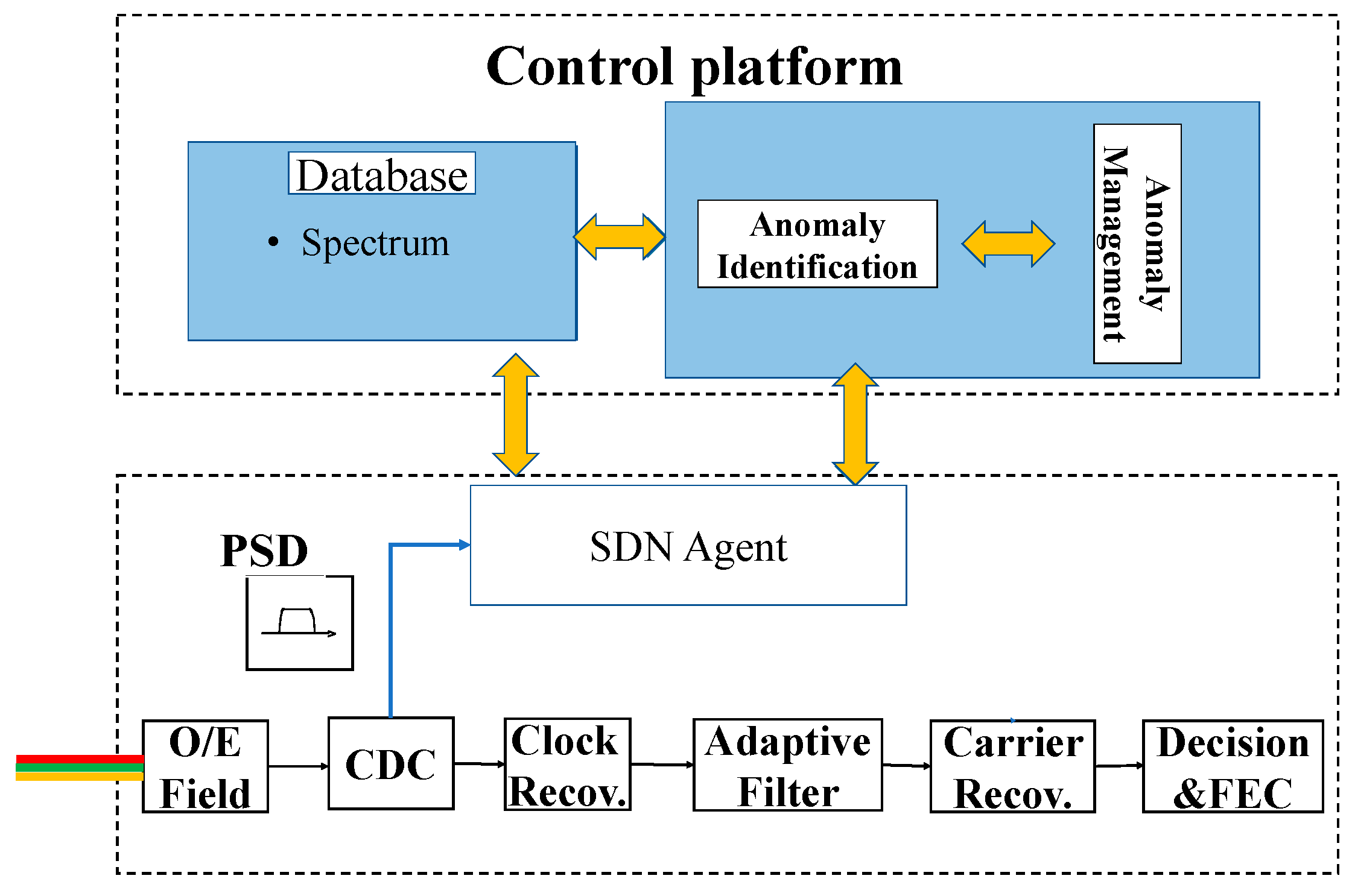
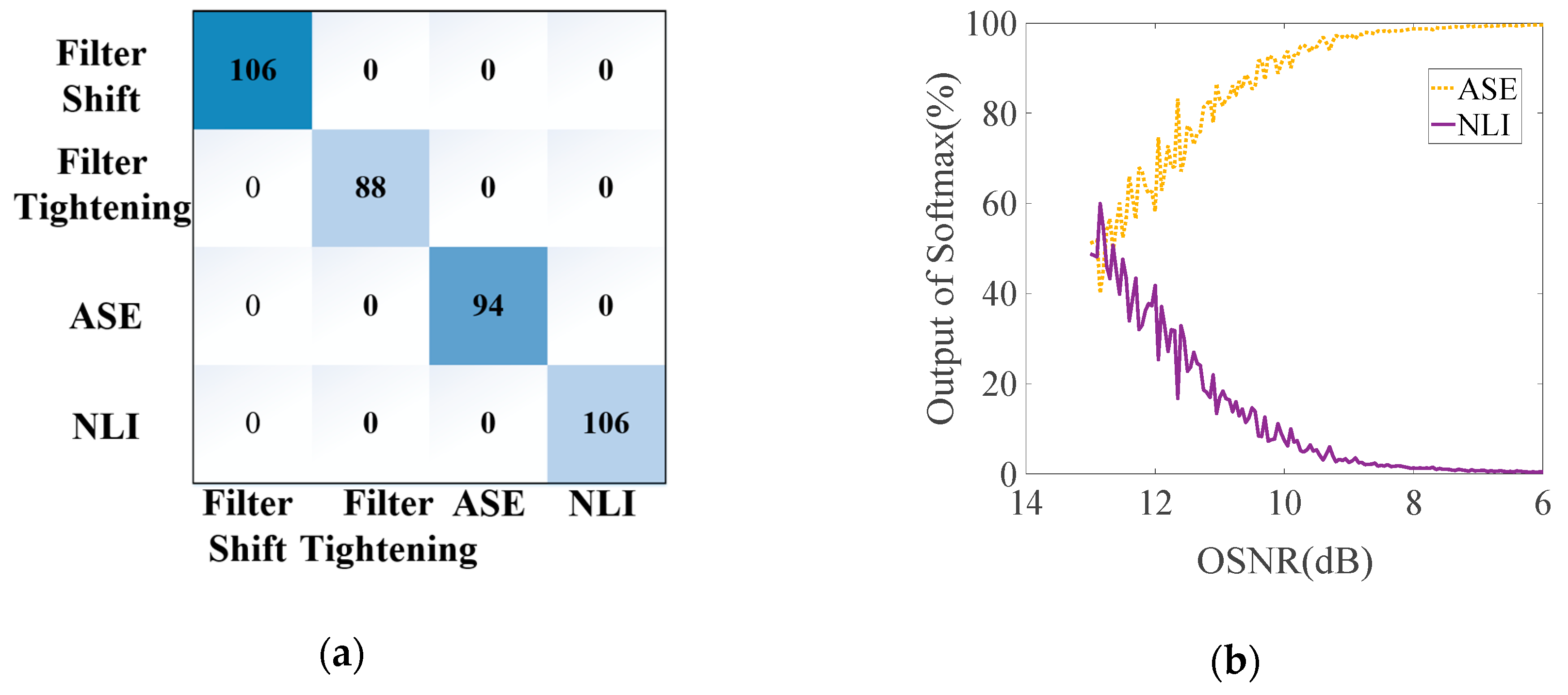
| Modeling Targets | Algorithms | Input Features |
|---|---|---|
| BER | K-Nearest Neighbors, Random Forest [4] | Traffic volume, modulation format, total length of links, length of the longest link, number of lightpath links |
| Stochastic Gradient Descent Polynomial Regression [21] | Generalized OSNR, baud rate, modulation format, FEC, slot-size | |
| Deep Graph Convolutional Neural Networks [46] | Total length of the path, span length, central frequency, number of slots in each path, modulation format, number of Erbium-doped fiber amplifier (EDFA), number of links, BER | |
| Q-factor | Case-based Reasoning [47,48] | Route, selected wavelength, total length of the path, sum of the co-propagating lightpaths per link, standard deviation of the number of total co-propagating lightpaths |
| Transfer Learning [33] | Channel loading, per-channel output power | |
| OSNR | Network Kriging, -norm Regularization [49] | Average PMD of each link, accumulation value of CD, the self-phase modulation (SPM) quantified through the nonlinear phase of the signal |
| Gaussian Process Regression [50] | Wavelength, OSNR of the established wavelength | |
| SNR | Combination of Machine Learning and Physical Layer Model [10] | Lightpath length, link load, number of crossed EDFAs |
| Gradient Decent [51] | Power, noise figure | |
| Margin | K-Nearest Neighbors, Linear Regression, Support Vector Machine, Artificial Neural Networks [38] | Number of hops, number of spans, total link length, average link length, maximum link length, average span attenuation, average CD |
| Modeling Targets | Algorithms | Input Features |
|---|---|---|
| Nonlinear Noise | Artificial Neural Networks [5] | Nonlinear SNR from the GN model, span number, maximum span length, average span length, optical launch power, link length, net CD, average gamma of fiber spans, average attenuation of fiber spans, number of wavelength-division multiplexing (WDM) channels |
| Optical Filtering Effect | Artificial Neural Networks [9] | Number of ROADMs, OSNR, loaded noise distribution, bandwidth distribution |
| Gain Spectrum of EDFA | Deep Neural Networks [34] | Power levels of all WDM channels |
| EDFA Gain Excursion | Multilayer Perceptron [35] | Gain setting, total input power, input power of each channel |
| Algorithms | Features | Monitoring Targets |
|---|---|---|
| Artificial Neural Networks [14] | Empirical asynchronously sampled signal amplitudes | OSNR, CD, PMD |
| Deep Neural Networks [57] | Asynchronously sampled raw data | OSNR |
| Convolutional Neural Network [58] | Constellation-diagram | OSNR, Modulation Format |
| Convolutional Neural Networks [13,59] | Horizontal and vertical polarization, in-phase and quadrature-phase components of optical signals | OSNR, Modulation Format |
| Artificial Neural Networks [37] | Launched power, EDFAs’ input powers, EDFAs’ output powers, EDFAs’ gains, EDFAs’ NFs, etc. | OSNR |
| Principal Component Analysis, Artificial Neural Networks [60] | Asynchronous delay-tap plots | OSNR, CD, Differential Group Delay (DGD), Joint Bit-rate and Modulation Format Identification (BR-MFI) |
| Principle Component Analysis, Artificial Neural Networks [61] | Asynchronous single channel sampling data | OSNR, Modulation Format |
| Deep Neural Networks [62] | Signals’ amplitude histograms | OSNR, Modulation Format |
| Kernel-based Ridge Regression [63] | Asynchronous delay-tap sampling data | CD, DGD |
| Long Short-Term Memory Neural Networks [64] | Four-tributary digital output | OSNR |
| Long Short-Term Memory Neural Networks [65] | Frequency domain signal | OSNR, Nonlinear Noise Power |
| Support Vector Machine [66] | Eye diagrams | CD, PMD, Noncoherent Crosstalk |
| Artificial Neural Networks [67] | Amplitude noise and phase noise correlation (ANC, PNC), number of WDM channel, total CD | Nonlinear SNR |
| Artificial Neural Networks [68] | Accumulative logarithmic ANC (ALANC), number of WDM channel, total CD, noise tangential and normal component | Nonlinear SNR |
| Support Vector Regression [69] | Amplitude noise correlation, logarithmic accumulated CD | Nonlinear SNR |
| Artificial Neural Networks [5] | Nonlinear SNR from GN model, span number, maximum span length, average span length, the launch power, link length, net CD, average gamma of fiber spans, average attenuation of fiber spans, number of WDM channels, ANC, PNC | Nonlinear SNR |
| Targets | Algorithms | Input Features |
|---|---|---|
| Detection, Identification | Finite State Machine [70] | BER, received power in receiver |
| Detection, Identification | Random Forests, Support Vector Machine [71] | The trend of BER |
| Identification | Convolutional Neural Networks [12] | Optical spectrum |
| Detection | Support Vector Machine, Decision Trees [15] | Optical spectrum |
| Detection | One-class Support Vector Machine [72] | Tap value of the adaptive filter |
| Features of modeling | 1. from the GN model |
| 2. Span number | |
| 3. Maximum span length | |
| 4. Average span length | |
| 5. Launch power | |
| 6. Link length | |
| 7. Net CD | |
| 8. Average gamma of fiber spans | |
| 9. Average alpha of fiber spans | |
| 10. Number of WDM channels |
© 2020 by the authors. Licensee MDPI, Basel, Switzerland. This article is an open access article distributed under the terms and conditions of the Creative Commons Attribution (CC BY) license (http://creativecommons.org/licenses/by/4.0/).
Share and Cite
Liu, X.; Lun, H.; Fu, M.; Fan, Y.; Yi, L.; Hu, W.; Zhuge, Q. AI-Based Modeling and Monitoring Techniques for Future Intelligent Elastic Optical Networks. Appl. Sci. 2020, 10, 363. https://doi.org/10.3390/app10010363
Liu X, Lun H, Fu M, Fan Y, Yi L, Hu W, Zhuge Q. AI-Based Modeling and Monitoring Techniques for Future Intelligent Elastic Optical Networks. Applied Sciences. 2020; 10(1):363. https://doi.org/10.3390/app10010363
Chicago/Turabian StyleLiu, Xiaomin, Huazhi Lun, Mengfan Fu, Yunyun Fan, Lilin Yi, Weisheng Hu, and Qunbi Zhuge. 2020. "AI-Based Modeling and Monitoring Techniques for Future Intelligent Elastic Optical Networks" Applied Sciences 10, no. 1: 363. https://doi.org/10.3390/app10010363
APA StyleLiu, X., Lun, H., Fu, M., Fan, Y., Yi, L., Hu, W., & Zhuge, Q. (2020). AI-Based Modeling and Monitoring Techniques for Future Intelligent Elastic Optical Networks. Applied Sciences, 10(1), 363. https://doi.org/10.3390/app10010363





